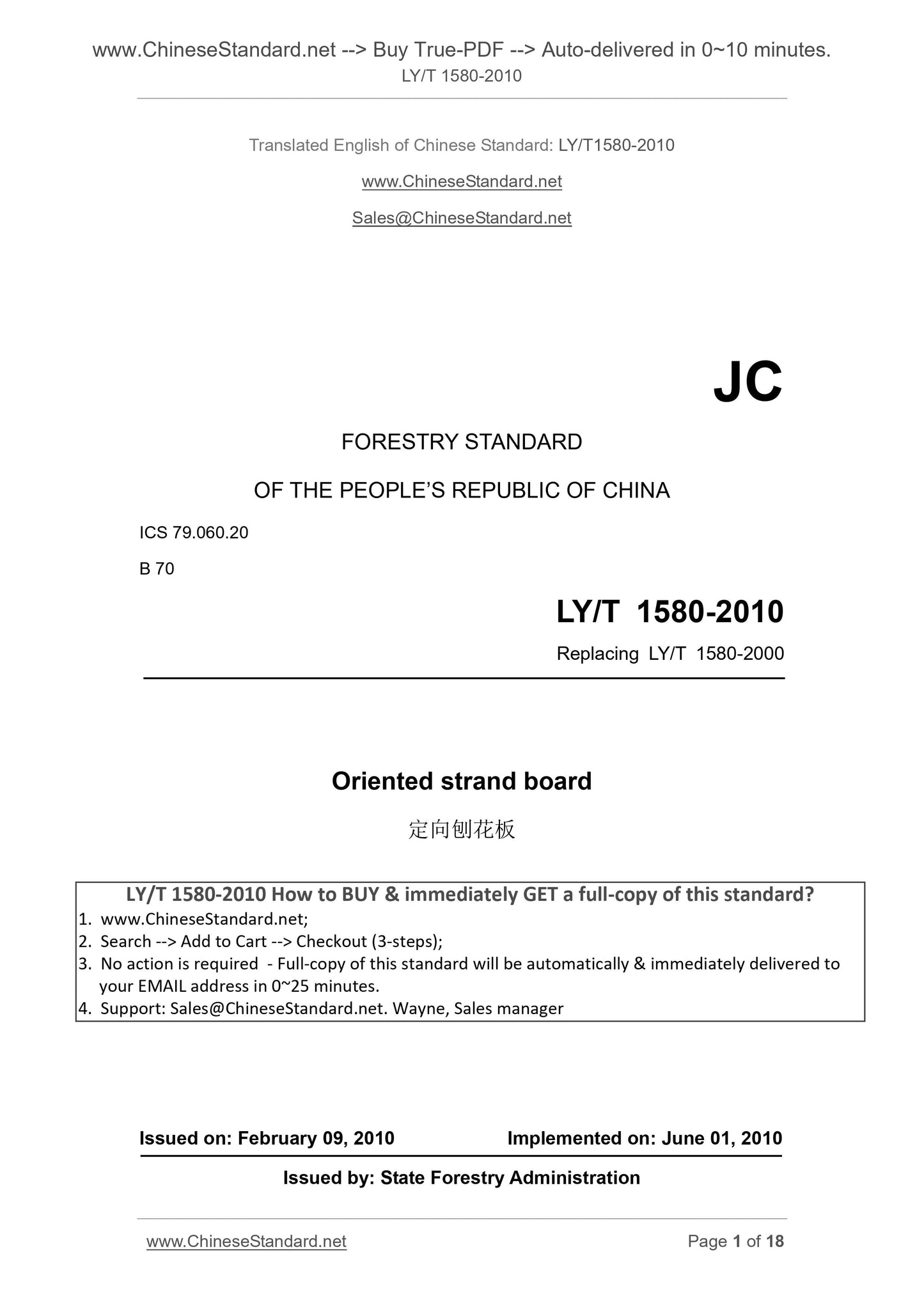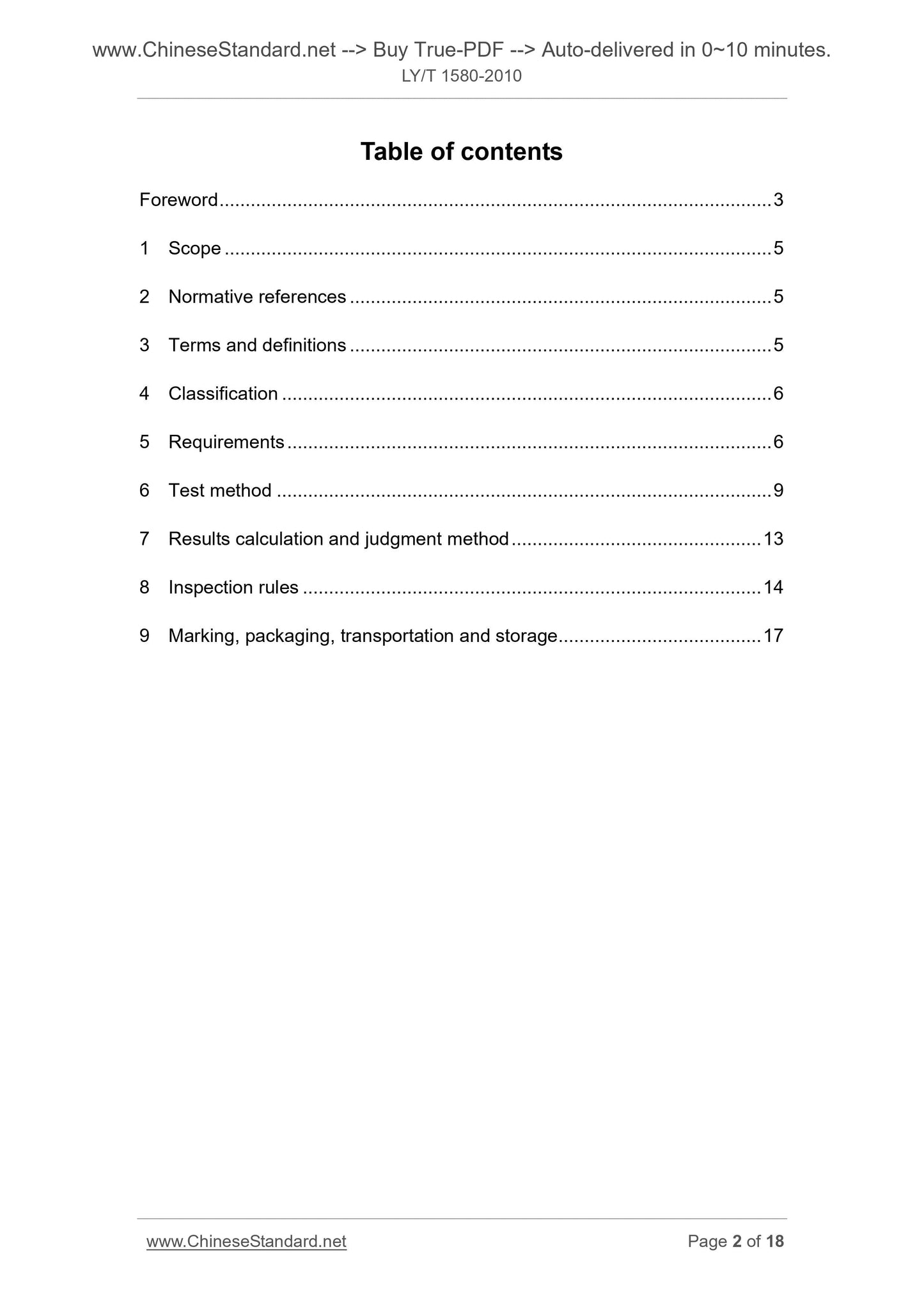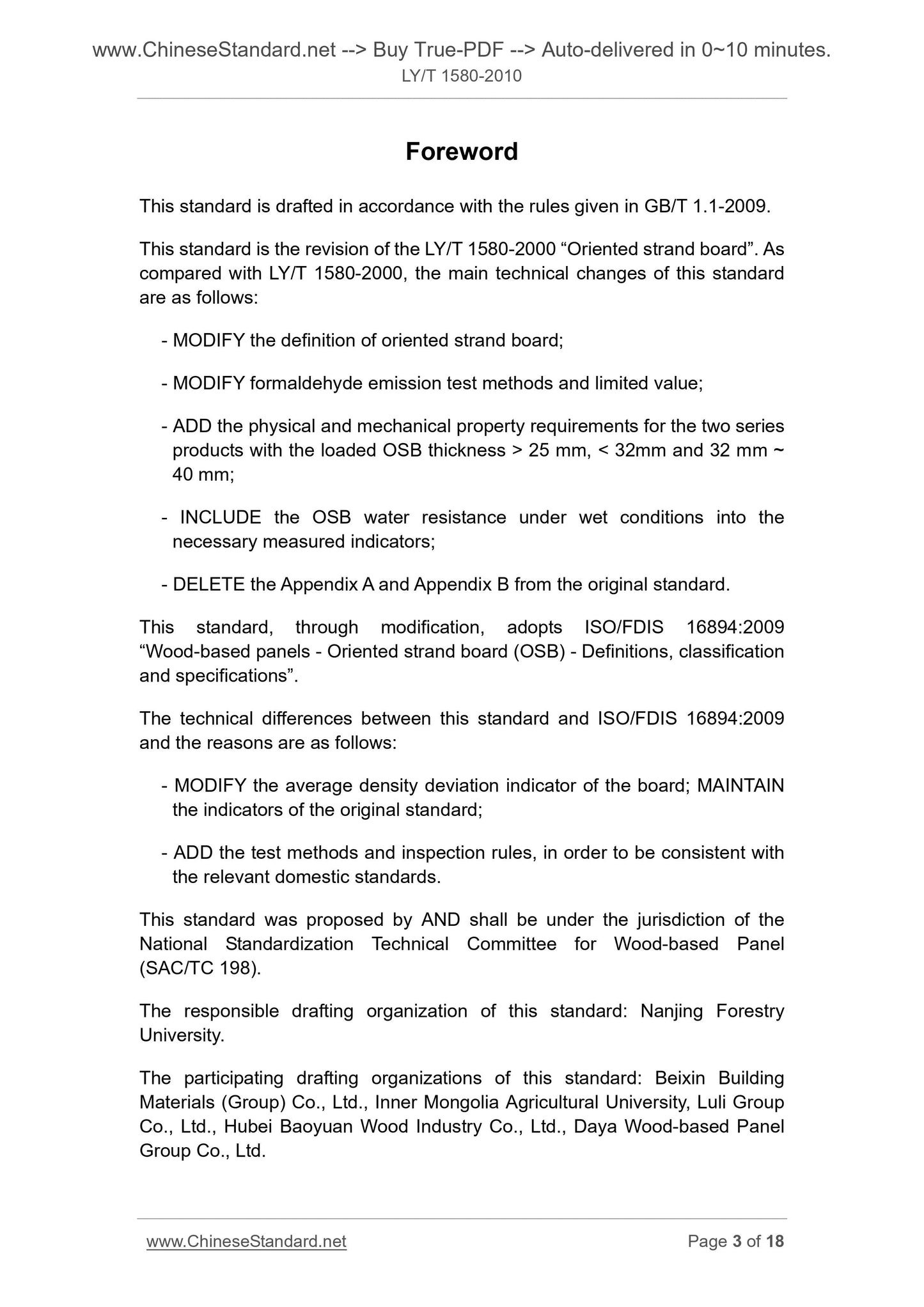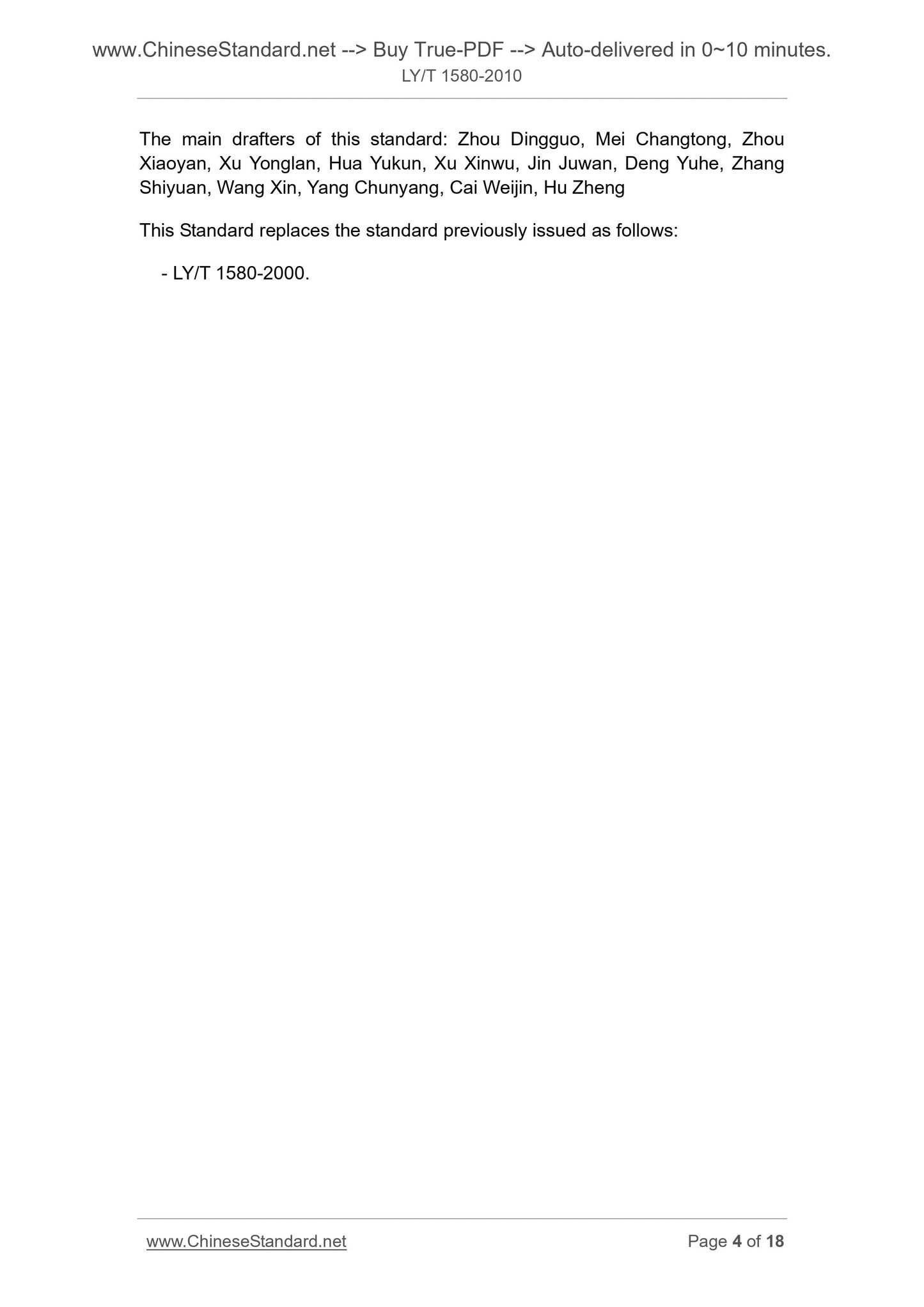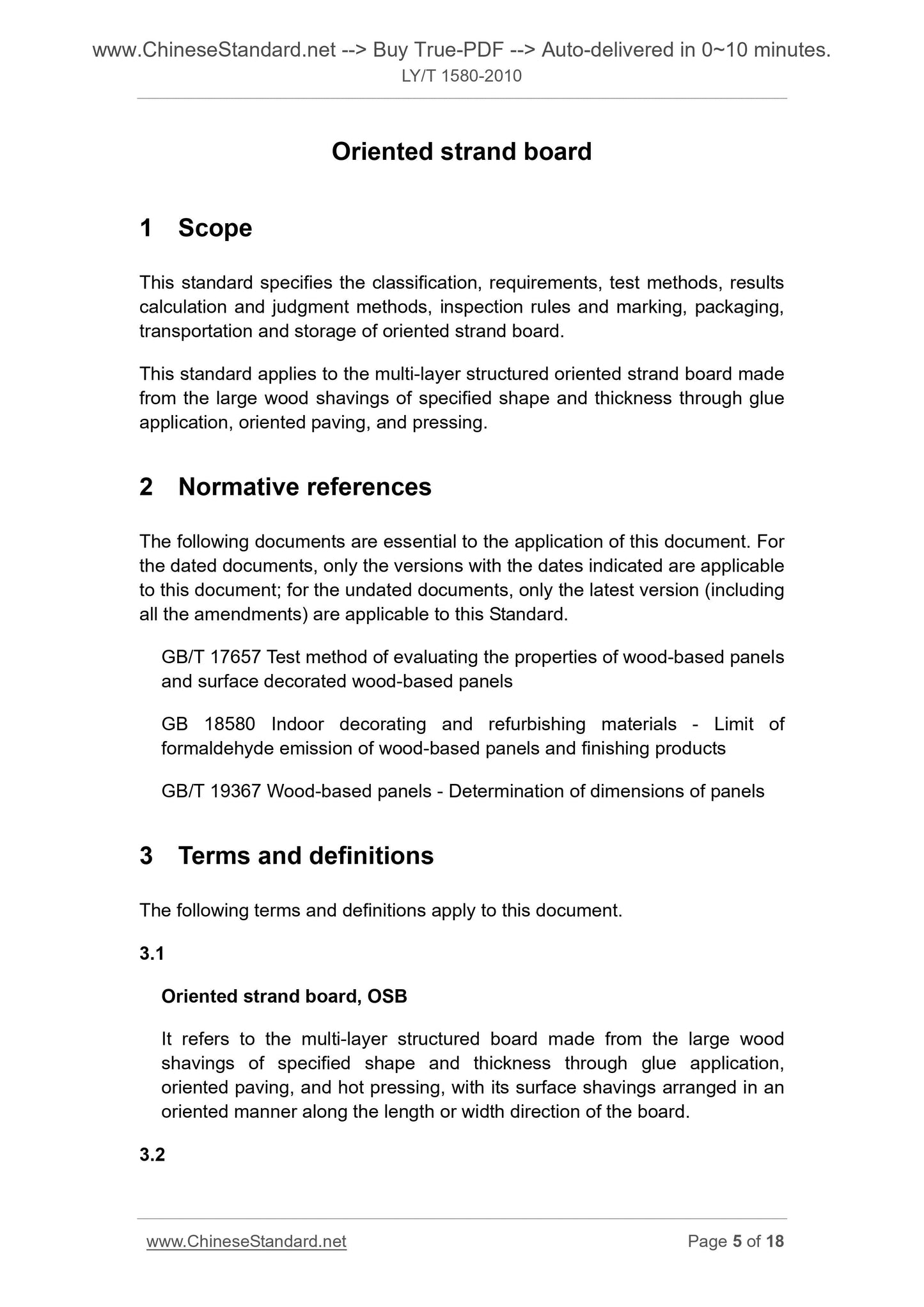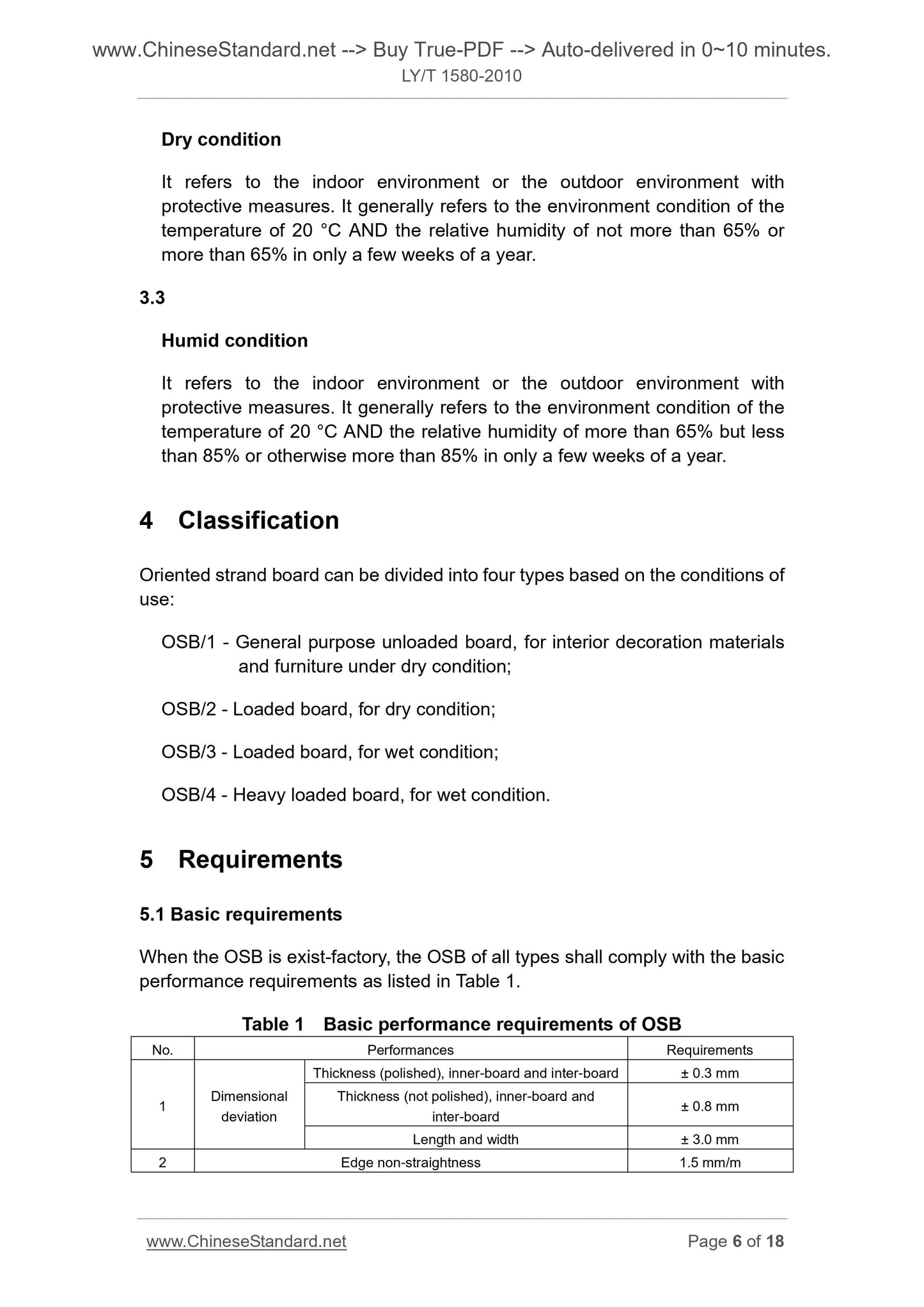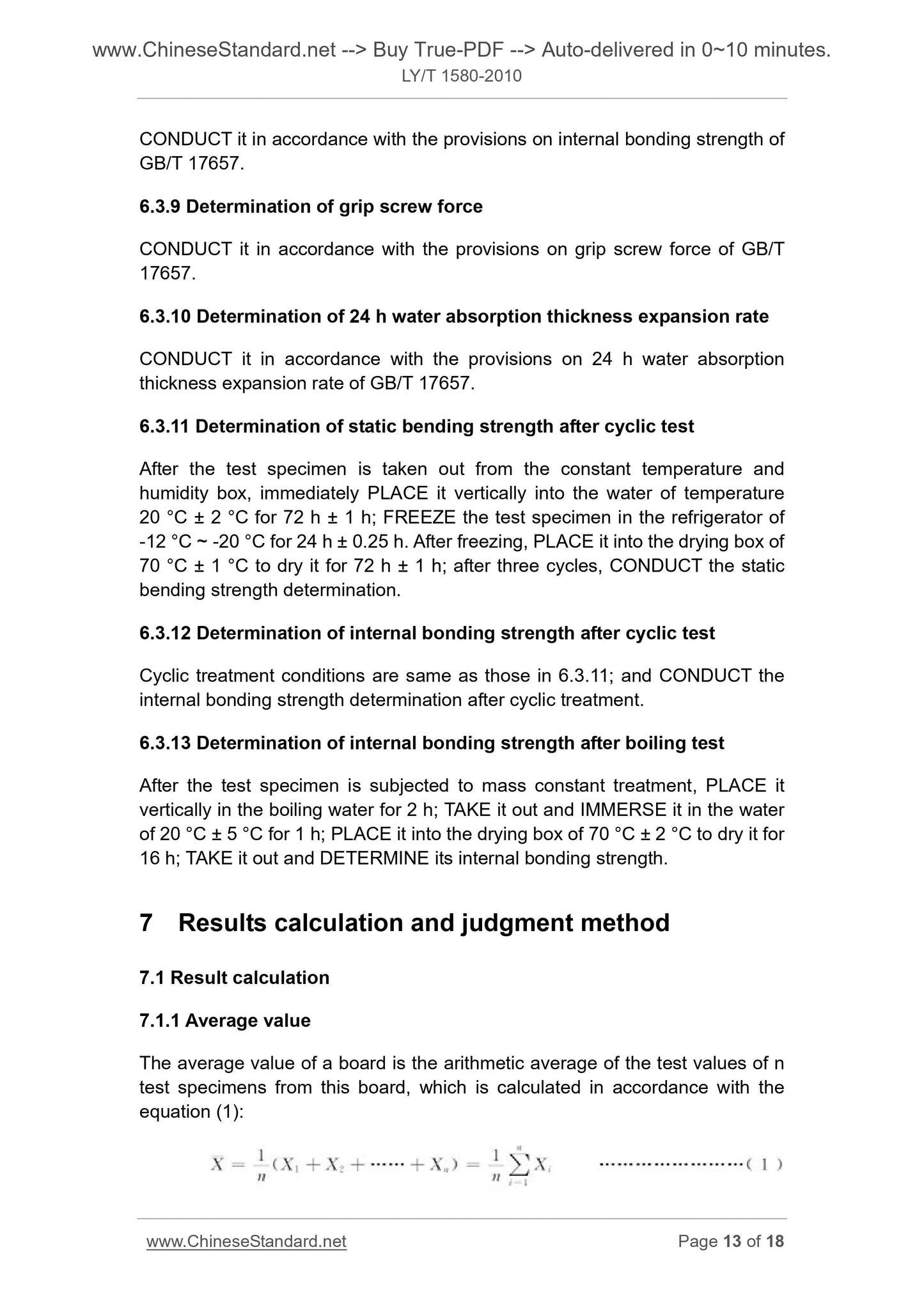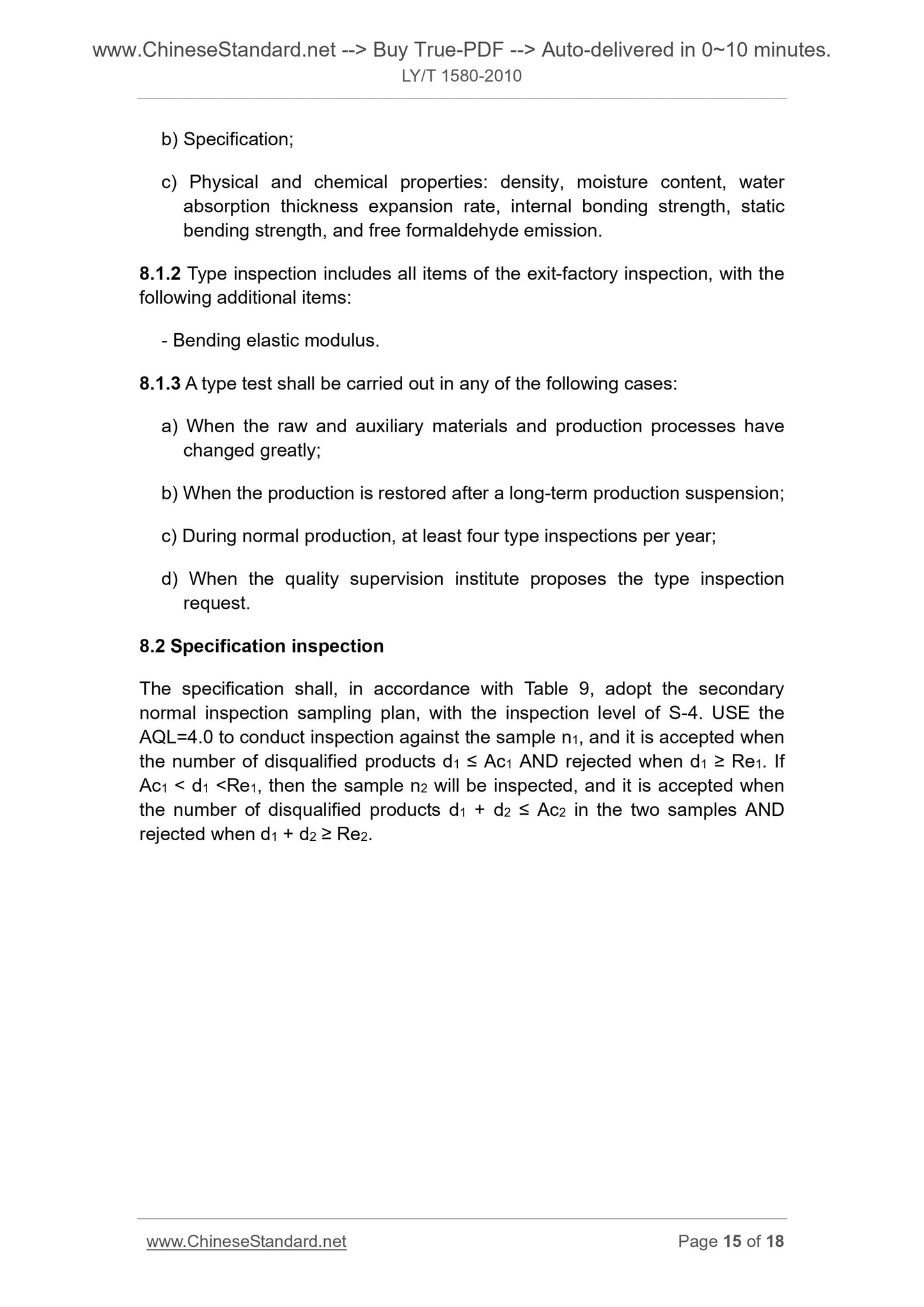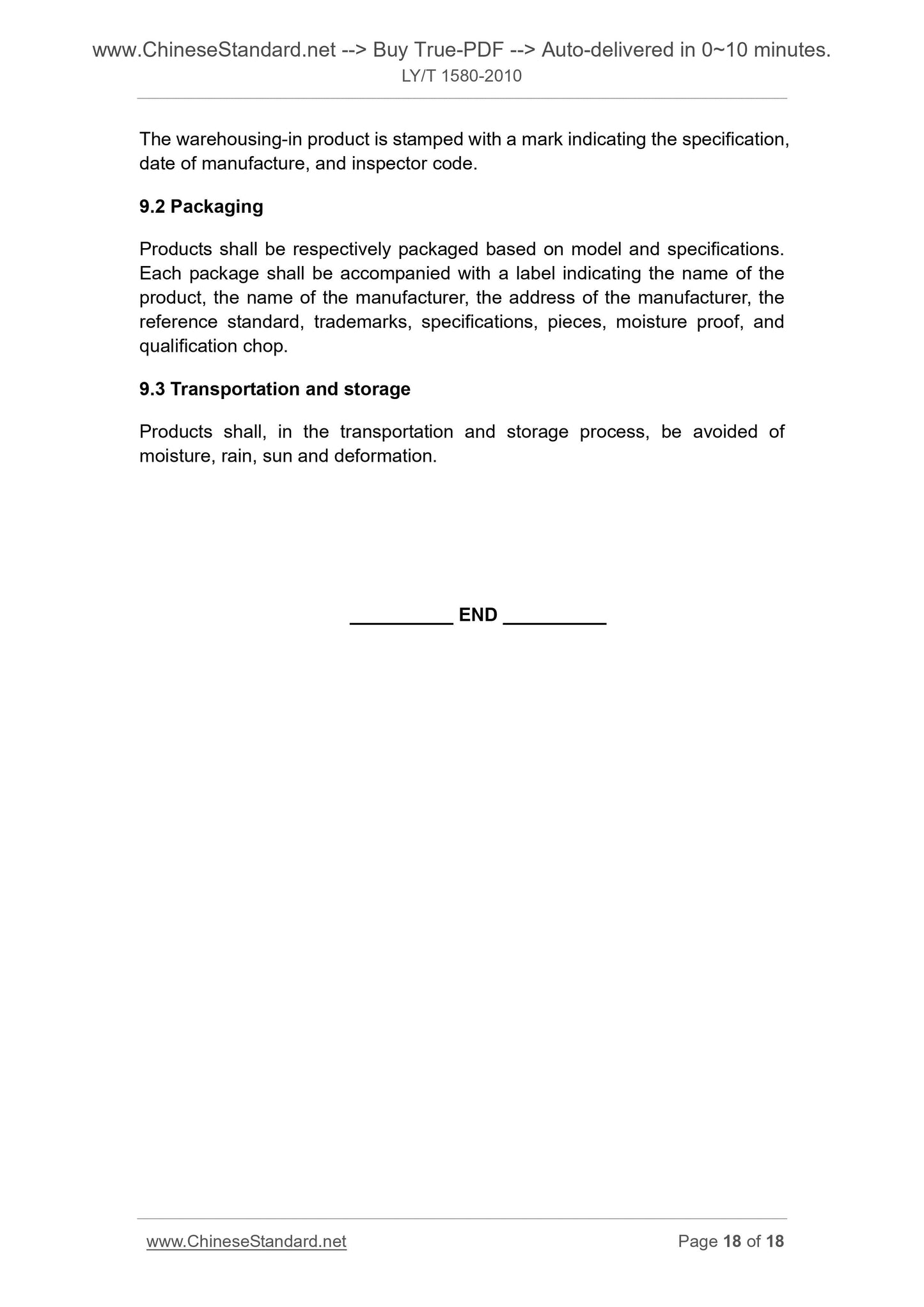1
/
von
9
PayPal, credit cards. Download editable-PDF and invoice in 1 second!
LY/T 1580-2010 English PDF (LYT1580-2010)
LY/T 1580-2010 English PDF (LYT1580-2010)
Normaler Preis
$145.00 USD
Normaler Preis
Verkaufspreis
$145.00 USD
Grundpreis
/
pro
Versand wird beim Checkout berechnet
Verfügbarkeit für Abholungen konnte nicht geladen werden
Delivery: 3 seconds. Download true-PDF + Invoice.
Get QUOTATION in 1-minute: Click LY/T 1580-2010
Historical versions: LY/T 1580-2010
Preview True-PDF (Reload/Scroll if blank)
LY/T 1580-2010: Oriented strand board
LY/T 1580-2010
JC
FORESTRY STANDARD
OF THE PEOPLE’S REPUBLIC OF CHINA
ICS 79.060.20
B 70
Replacing LY/T 1580-2000
Oriented strand board
ISSUED ON. FEBRUARY 09, 2010
IMPLEMENTED ON. JUNE 01, 2010
Issued by. State Forestry Administration
Table of contents
Foreword ... 3
1 Scope ... 5
2 Normative references ... 5
3 Terms and definitions ... 5
4 Classification ... 6
5 Requirements ... 6
6 Test method ... 9
7 Results calculation and judgment method ... 13
8 Inspection rules ... 14
9 Marking, packaging, transportation and storage ... 17
Foreword
This standard is drafted in accordance with the rules given in GB/T 1.1-2009.
This standard is the revision of the LY/T 1580-2000 “Oriented strand board”. As
compared with LY/T 1580-2000, the main technical changes of this standard
are as follows.
- MODIFY the definition of oriented strand board;
- MODIFY formaldehyde emission test methods and limited value;
- ADD the physical and mechanical property requirements for the two series
products with the loaded OSB thickness > 25 mm, < 32mm and 32 mm ~
40 mm;
- INCLUDE the OSB water resistance under wet conditions into the
necessary measured indicators;
- DELETE the Appendix A and Appendix B from the original standard.
This standard, through modification, adopts ISO/FDIS 16894.2009
“Wood-based panels - Oriented strand board (OSB) - Definitions, classification
and specifications”.
The technical differences between this standard and ISO/FDIS 16894.2009
and the reasons are as follows.
- MODIFY the average density deviation indicator of the board; MAINTAIN
the indicators of the original standard;
- ADD the test methods and inspection rules, in order to be consistent with
the relevant domestic standards.
This standard was proposed by AND shall be under the jurisdiction of the
National Standardization Technical Committee for Wood-based Panel
(SAC/TC 198).
The responsible drafting organization of this standard. Nanjing Forestry
University.
The participating drafting organizations of this standard. Beixin Building
Materials (Group) Co., Ltd., Inner Mongolia Agricultural University, Luli Group
Co., Ltd., Hubei Baoyuan Wood Industry Co., Ltd., Daya Wood-based Panel
Group Co., Ltd.
The main drafters of this standard. Zhou Dingguo, Mei Changtong, Zhou
Xiaoyan, Xu Yonglan, Hua Yukun, Xu Xinwu, Jin Juwan, Deng Yuhe, Zhang
Shiyuan, Wang Xin, Yang Chunyang, Cai Weijin, Hu Zheng
This Standard replaces the standard previously issued as follows.
- LY/T 1580-2000.
Oriented strand board
1 Scope
This standard specifies the classification, requirements, test methods, results
calculation and judgment methods, inspection rules and marking, packaging,
transportation and storage of oriented strand board.
This standard applies to the multi-layer structured oriented strand board made
from the large wood shavings of specified shape and thickness through glue
application, oriented paving, and pressing.
2 Normative references
The following documents are essential to the application of this document. For
the dated documents, only the versions with the dates indicated are applicable
to this document; for the undated documents, only the latest version (including
all the amendments) are applicable to this Standard.
GB/T 17657 Test method of evaluating the properties of wood-based panels
and surface decorated wood-based panels
GB 18580 Indoor decorating and refurbishing materials - Limit of
formaldehyde emission of wood-based panels and finishing products
GB/T 19367 Wood-based panels - Determination of dimensions of panels
3 Terms and definitions
The following terms and definitions apply to this document.
3.1
Oriented strand board, OSB
It refers to the multi-layer structured board made from the large wood
shavings of specified shape and thickness through glue application,
oriented paving, and hot pressing, with its surface shavings arranged in an
oriented manner along the length or width direction of the board.
3.2
Dry condition
It refers to the indoor environment or the outdoor environment with
protective measures. It generally refers to the environment condition of the
temperature of 20 °C AND the relative humidity of not more than 65% or
more than 65% in only a few weeks of a year.
3.3
Humid condition
It refers to the indoor environment or the outdoor environment with
protective measures. It generally refers to the environment condition of the
temperature of 20 °C AND the relative humidity of more than 65% but less
than 85% or otherwise more than 85% in only a few weeks of a year.
4 Classification
Oriented strand board can be divided into four types based on the conditions of
use.
OSB/1 - General purpose unloaded board, for interior decoration materials
and furniture under dry condition;
OSB/2 - Loaded board, for dry condition;
OSB/3 - Loaded board, for wet condition;
OSB/4 - Heavy loaded board, for wet condition.
5 Requirements
5.1 Basic requirements
When the OSB is exist-factory, the OSB of all types shall comply with the basic
performance requirements as listed in Table 1.
Table 1 Basic performance requirements of OSB
No. Performances Requirements
1 Dimensional deviation
Thickness (polished), inner-board and inter-board ± 0.3 mm
Thickness (not polished), inner-board and
inter-board ± 0.8 mm
Length and width ± 3.0 mm
2 Edge non-straightness 1.5 mm/m
CONDUCT it in accordance with the provisions on internal bonding strength of
GB/T 17657.
6.3.9 Determination of grip screw force
CONDUCT it in accordance with the provisions on grip screw force of GB/T
17657.
6.3.10 Determination of 24 h water absorption thickness expansion rate
CONDUCT it in accordance with the provisions on 24 h water absorption
thickness expansion rate of GB/T 17657.
6.3.11 Determination of static bending strength after cyclic test
After the test specimen is taken out from the constant temperature and
humidity box, immediately PLACE it vertically into the water of temperature
20 °C ± 2 °C for 72 h ± 1 h; FREEZE the test specimen in the refrigerator of
-12 °C ~ -20 °C for 24 h ± 0.25 h. After freezing, PLACE it into the drying box of
70 °C ± 1 °C to dry it for 72 h ± 1 h; after three cycles, CONDUCT the static
bending strength determination.
6.3.12 Determination of internal bonding strength after cyclic test
Cyclic treatment conditions are same as those in 6.3.11; and CONDUCT the
internal bonding strength determination after cyclic treatment.
6.3.13 Determination of internal bonding strength after boiling test
After the test specimen is subjected to mass constant treatment, PLACE it
vertically in the boiling water for 2 h; TAKE it out and IMMERSE it in the water
of 20 °C ± 5 °C for 1 h; PLACE it into the drying box of 70 °C ± 2 °C to dry it for
16 h; TAKE it out and DETERMINE its internal bonding strength.
7 Results calculation and judgment method
7.1 Result calculation
7.1.1 Average value
The average value of a board is the arithmetic average of the test values of n
test specimens from this board, which is calculated in accordance with the
equation (1).
b) Specification;
c) Physical and chemical properties. density, moisture content, water
absorption thickness expansion rate, internal bonding strength, static
bending strength, and free formaldehyde emission.
8.1.2 Type inspection includes all i...
Get QUOTATION in 1-minute: Click LY/T 1580-2010
Historical versions: LY/T 1580-2010
Preview True-PDF (Reload/Scroll if blank)
LY/T 1580-2010: Oriented strand board
LY/T 1580-2010
JC
FORESTRY STANDARD
OF THE PEOPLE’S REPUBLIC OF CHINA
ICS 79.060.20
B 70
Replacing LY/T 1580-2000
Oriented strand board
ISSUED ON. FEBRUARY 09, 2010
IMPLEMENTED ON. JUNE 01, 2010
Issued by. State Forestry Administration
Table of contents
Foreword ... 3
1 Scope ... 5
2 Normative references ... 5
3 Terms and definitions ... 5
4 Classification ... 6
5 Requirements ... 6
6 Test method ... 9
7 Results calculation and judgment method ... 13
8 Inspection rules ... 14
9 Marking, packaging, transportation and storage ... 17
Foreword
This standard is drafted in accordance with the rules given in GB/T 1.1-2009.
This standard is the revision of the LY/T 1580-2000 “Oriented strand board”. As
compared with LY/T 1580-2000, the main technical changes of this standard
are as follows.
- MODIFY the definition of oriented strand board;
- MODIFY formaldehyde emission test methods and limited value;
- ADD the physical and mechanical property requirements for the two series
products with the loaded OSB thickness > 25 mm, < 32mm and 32 mm ~
40 mm;
- INCLUDE the OSB water resistance under wet conditions into the
necessary measured indicators;
- DELETE the Appendix A and Appendix B from the original standard.
This standard, through modification, adopts ISO/FDIS 16894.2009
“Wood-based panels - Oriented strand board (OSB) - Definitions, classification
and specifications”.
The technical differences between this standard and ISO/FDIS 16894.2009
and the reasons are as follows.
- MODIFY the average density deviation indicator of the board; MAINTAIN
the indicators of the original standard;
- ADD the test methods and inspection rules, in order to be consistent with
the relevant domestic standards.
This standard was proposed by AND shall be under the jurisdiction of the
National Standardization Technical Committee for Wood-based Panel
(SAC/TC 198).
The responsible drafting organization of this standard. Nanjing Forestry
University.
The participating drafting organizations of this standard. Beixin Building
Materials (Group) Co., Ltd., Inner Mongolia Agricultural University, Luli Group
Co., Ltd., Hubei Baoyuan Wood Industry Co., Ltd., Daya Wood-based Panel
Group Co., Ltd.
The main drafters of this standard. Zhou Dingguo, Mei Changtong, Zhou
Xiaoyan, Xu Yonglan, Hua Yukun, Xu Xinwu, Jin Juwan, Deng Yuhe, Zhang
Shiyuan, Wang Xin, Yang Chunyang, Cai Weijin, Hu Zheng
This Standard replaces the standard previously issued as follows.
- LY/T 1580-2000.
Oriented strand board
1 Scope
This standard specifies the classification, requirements, test methods, results
calculation and judgment methods, inspection rules and marking, packaging,
transportation and storage of oriented strand board.
This standard applies to the multi-layer structured oriented strand board made
from the large wood shavings of specified shape and thickness through glue
application, oriented paving, and pressing.
2 Normative references
The following documents are essential to the application of this document. For
the dated documents, only the versions with the dates indicated are applicable
to this document; for the undated documents, only the latest version (including
all the amendments) are applicable to this Standard.
GB/T 17657 Test method of evaluating the properties of wood-based panels
and surface decorated wood-based panels
GB 18580 Indoor decorating and refurbishing materials - Limit of
formaldehyde emission of wood-based panels and finishing products
GB/T 19367 Wood-based panels - Determination of dimensions of panels
3 Terms and definitions
The following terms and definitions apply to this document.
3.1
Oriented strand board, OSB
It refers to the multi-layer structured board made from the large wood
shavings of specified shape and thickness through glue application,
oriented paving, and hot pressing, with its surface shavings arranged in an
oriented manner along the length or width direction of the board.
3.2
Dry condition
It refers to the indoor environment or the outdoor environment with
protective measures. It generally refers to the environment condition of the
temperature of 20 °C AND the relative humidity of not more than 65% or
more than 65% in only a few weeks of a year.
3.3
Humid condition
It refers to the indoor environment or the outdoor environment with
protective measures. It generally refers to the environment condition of the
temperature of 20 °C AND the relative humidity of more than 65% but less
than 85% or otherwise more than 85% in only a few weeks of a year.
4 Classification
Oriented strand board can be divided into four types based on the conditions of
use.
OSB/1 - General purpose unloaded board, for interior decoration materials
and furniture under dry condition;
OSB/2 - Loaded board, for dry condition;
OSB/3 - Loaded board, for wet condition;
OSB/4 - Heavy loaded board, for wet condition.
5 Requirements
5.1 Basic requirements
When the OSB is exist-factory, the OSB of all types shall comply with the basic
performance requirements as listed in Table 1.
Table 1 Basic performance requirements of OSB
No. Performances Requirements
1 Dimensional deviation
Thickness (polished), inner-board and inter-board ± 0.3 mm
Thickness (not polished), inner-board and
inter-board ± 0.8 mm
Length and width ± 3.0 mm
2 Edge non-straightness 1.5 mm/m
CONDUCT it in accordance with the provisions on internal bonding strength of
GB/T 17657.
6.3.9 Determination of grip screw force
CONDUCT it in accordance with the provisions on grip screw force of GB/T
17657.
6.3.10 Determination of 24 h water absorption thickness expansion rate
CONDUCT it in accordance with the provisions on 24 h water absorption
thickness expansion rate of GB/T 17657.
6.3.11 Determination of static bending strength after cyclic test
After the test specimen is taken out from the constant temperature and
humidity box, immediately PLACE it vertically into the water of temperature
20 °C ± 2 °C for 72 h ± 1 h; FREEZE the test specimen in the refrigerator of
-12 °C ~ -20 °C for 24 h ± 0.25 h. After freezing, PLACE it into the drying box of
70 °C ± 1 °C to dry it for 72 h ± 1 h; after three cycles, CONDUCT the static
bending strength determination.
6.3.12 Determination of internal bonding strength after cyclic test
Cyclic treatment conditions are same as those in 6.3.11; and CONDUCT the
internal bonding strength determination after cyclic treatment.
6.3.13 Determination of internal bonding strength after boiling test
After the test specimen is subjected to mass constant treatment, PLACE it
vertically in the boiling water for 2 h; TAKE it out and IMMERSE it in the water
of 20 °C ± 5 °C for 1 h; PLACE it into the drying box of 70 °C ± 2 °C to dry it for
16 h; TAKE it out and DETERMINE its internal bonding strength.
7 Results calculation and judgment method
7.1 Result calculation
7.1.1 Average value
The average value of a board is the arithmetic average of the test values of n
test specimens from this board, which is calculated in accordance with the
equation (1).
b) Specification;
c) Physical and chemical properties. density, moisture content, water
absorption thickness expansion rate, internal bonding strength, static
bending strength, and free formaldehyde emission.
8.1.2 Type inspection includes all i...
Share
